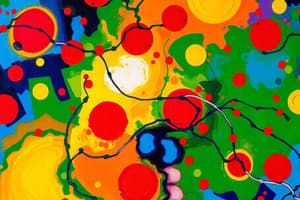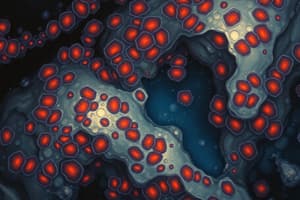Podcast
Questions and Answers
A cell releases a signaling molecule that binds to receptors on its own surface and on neighboring cells of a different type. This type of signaling is best described as which of the following?
A cell releases a signaling molecule that binds to receptors on its own surface and on neighboring cells of a different type. This type of signaling is best described as which of the following?
- Both autocrine and paracrine signaling (correct)
- Juxtacrine signaling only
- Paracrine signaling only
- Autocrine signaling only
Which of the following is a critical difference between water-soluble and lipid-soluble hormones in the context of cell signaling?
Which of the following is a critical difference between water-soluble and lipid-soluble hormones in the context of cell signaling?
- Water-soluble hormones directly influence gene transcription, while lipid-soluble hormones bind to cell surface receptors.
- Water-soluble hormones are transported in the bloodstream via carrier proteins, while lipid-soluble hormones dissolve directly in the blood.
- Water-soluble hormones bind to cell surface receptors and often act through signal transduction cascades, while lipid-soluble hormones typically bind to intracellular receptors and directly influence gene transcription. (correct)
- Water-soluble hormones typically act through intracellular receptors, while lipid-soluble hormones bind to cell surface receptors.
In the context of G-protein coupled receptors (GPCRs), what is the correct order of events following ligand binding to the receptor?
In the context of G-protein coupled receptors (GPCRs), what is the correct order of events following ligand binding to the receptor?
- Ligand binding → G protein activation → Adenylyl cyclase activation → Increase in cAMP → Protein kinase A (PKA) activation.
- Ligand binding → G protein activation → Phospholipase C activation → Increase in DAG and IP3 → Activation of protein kinase C (PKC).
- Ligand binding → G protein activation → Change in G protein conformation → Release of GDP and binding of GTP → Dissociation of G protein subunits.
- All of the above (correct)
Receptor tyrosine kinases (RTKs) are transmembrane receptors that, upon ligand binding, initiate a signaling cascade by which mechanism?
Receptor tyrosine kinases (RTKs) are transmembrane receptors that, upon ligand binding, initiate a signaling cascade by which mechanism?
Which of the following statements accurately distinguishes between direct enzymatic activity and mediated enzymatic activity in receptors?
Which of the following statements accurately distinguishes between direct enzymatic activity and mediated enzymatic activity in receptors?
Cytochrome c553 utilizes a heme prosthetic group as a ligand. What is the primary role of this ligand in the context of cellular signaling?
Cytochrome c553 utilizes a heme prosthetic group as a ligand. What is the primary role of this ligand in the context of cellular signaling?
How do water-soluble hormones typically initiate a cellular response, considering their properties?
How do water-soluble hormones typically initiate a cellular response, considering their properties?
A researcher is studying a novel receptor that, upon ligand binding, activates adenylyl cyclase. Based on the information, which receptor class does this novel receptor most likely belong to?
A researcher is studying a novel receptor that, upon ligand binding, activates adenylyl cyclase. Based on the information, which receptor class does this novel receptor most likely belong to?
Which of the following receptor classes directly engages in enzymatic activity upon activation by its ligand?
Which of the following receptor classes directly engages in enzymatic activity upon activation by its ligand?
A pharmaceutical company is developing a drug that targets a receptor involved in cell death. Which receptor class should they focus on to directly induce apoptosis through accessory proteins?
A pharmaceutical company is developing a drug that targets a receptor involved in cell death. Which receptor class should they focus on to directly induce apoptosis through accessory proteins?
A mutation causes a receptor protein to be constitutively active, even in the absence of its ligand. Which of the following consequences is most likely to occur?
A mutation causes a receptor protein to be constitutively active, even in the absence of its ligand. Which of the following consequences is most likely to occur?
In a signaling pathway, a protein kinase is responsible for phosphorylating and activating a downstream target protein. If this kinase is mutated such that it can no longer perform phosphorylation, what is the most likely outcome?
In a signaling pathway, a protein kinase is responsible for phosphorylating and activating a downstream target protein. If this kinase is mutated such that it can no longer perform phosphorylation, what is the most likely outcome?
A cell is exposed to a constant concentration of a ligand that normally induces a transient (short-lived) response. However, in this cell, the response remains active for an extended period. Which of the following defects could explain this prolonged response?
A cell is exposed to a constant concentration of a ligand that normally induces a transient (short-lived) response. However, in this cell, the response remains active for an extended period. Which of the following defects could explain this prolonged response?
Which of the following scenarios would most likely result in a cell failing to generate a signal?
Which of the following scenarios would most likely result in a cell failing to generate a signal?
A researcher discovers a new drug that prevents a receptor from undergoing a conformational change after ligand binding. What is the most likely consequence of this drug's action?
A researcher discovers a new drug that prevents a receptor from undergoing a conformational change after ligand binding. What is the most likely consequence of this drug's action?
A transcription factor is mutated such that it is always located in the nucleus, regardless of upstream signaling events. What is the likely consequence of this mutation?
A transcription factor is mutated such that it is always located in the nucleus, regardless of upstream signaling events. What is the likely consequence of this mutation?
In a paracrine signaling pathway, a signaling cell secretes a growth factor that stimulates proliferation in neighboring cells. If the signaling cell overexpresses a decoy receptor that binds the growth factor but does not initiate an intracellular signal, what is the likely outcome?
In a paracrine signaling pathway, a signaling cell secretes a growth factor that stimulates proliferation in neighboring cells. If the signaling cell overexpresses a decoy receptor that binds the growth factor but does not initiate an intracellular signal, what is the likely outcome?
A signaling pathway is considered 'off' when no ligand is present. What is the most immediate consequence of this state?
A signaling pathway is considered 'off' when no ligand is present. What is the most immediate consequence of this state?
Which ligand-binding model emphasizes a rigid, pre-existing complementary shape between the ligand and the binding site?
Which ligand-binding model emphasizes a rigid, pre-existing complementary shape between the ligand and the binding site?
In the induced fit model of ligand-protein binding, what primarily drives the binding process?
In the induced fit model of ligand-protein binding, what primarily drives the binding process?
Which ligand-binding model accounts for the inherent flexibility and dynamic conformational changes of proteins prior to ligand binding?
Which ligand-binding model accounts for the inherent flexibility and dynamic conformational changes of proteins prior to ligand binding?
What distinguishes the conformational selection model from the induced fit model?
What distinguishes the conformational selection model from the induced fit model?
If a researcher discovers that a particular protein-ligand interaction involves both conformational changes in the protein and a degree of pre-existing shape complementarity, which statement best describes this interaction?
If a researcher discovers that a particular protein-ligand interaction involves both conformational changes in the protein and a degree of pre-existing shape complementarity, which statement best describes this interaction?
A drug molecule binds to a receptor, preventing the natural ligand from binding. Based on the information, how would you classify this drug molecule?
A drug molecule binds to a receptor, preventing the natural ligand from binding. Based on the information, how would you classify this drug molecule?
In a signaling pathway, what determines whether a molecule is classified as a ligand?
In a signaling pathway, what determines whether a molecule is classified as a ligand?
A mutation in a receptor protein prevents it from undergoing the conformational change necessary for downstream signaling, even when the appropriate ligand is bound. Which ligand binding model is most directly affected by this mutation?
A mutation in a receptor protein prevents it from undergoing the conformational change necessary for downstream signaling, even when the appropriate ligand is bound. Which ligand binding model is most directly affected by this mutation?
Researchers are studying a protein that exists in multiple conformations in solution. They discover that a specific ligand only binds strongly to one of these pre-existing conformations. Which binding model best explains this observation?
Researchers are studying a protein that exists in multiple conformations in solution. They discover that a specific ligand only binds strongly to one of these pre-existing conformations. Which binding model best explains this observation?
Flashcards
Autocrine Signaling
Autocrine Signaling
Signaling where a cell signals itself.
Juxtacrine Signaling
Juxtacrine Signaling
Signaling to adjacent cells through direct contact.
Paracrine Signaling
Paracrine Signaling
Signaling to nearby cells through the release of signaling molecules. Think local!
Endocrine Signaling
Endocrine Signaling
Signup and view all the flashcards
G-Coupled Protein Receptors
G-Coupled Protein Receptors
Signup and view all the flashcards
Initiation (Signaling)
Initiation (Signaling)
Signup and view all the flashcards
Propagation (Signaling)
Propagation (Signaling)
Signup and view all the flashcards
Termination/Reset (Signaling)
Termination/Reset (Signaling)
Signup and view all the flashcards
Post-translational Modifications
Post-translational Modifications
Signup and view all the flashcards
Ligand
Ligand
Signup and view all the flashcards
Receptors
Receptors
Signup and view all the flashcards
Lock and Key Model
Lock and Key Model
Signup and view all the flashcards
Induced Fit Model
Induced Fit Model
Signup and view all the flashcards
Conformational Selection Model
Conformational Selection Model
Signup and view all the flashcards
Entropy-Dominated Process
Entropy-Dominated Process
Signup and view all the flashcards
Enthalpy-Dominated Process
Enthalpy-Dominated Process
Signup and view all the flashcards
Sequential entropy-enthalpy process
Sequential entropy-enthalpy process
Signup and view all the flashcards
Protein Ligand
Protein Ligand
Signup and view all the flashcards
No ligand - No signaling.
No ligand - No signaling.
Signup and view all the flashcards
Ligand receptor location
Ligand receptor location
Signup and view all the flashcards
What is a Ligand?
What is a Ligand?
Signup and view all the flashcards
Lipid-Soluble Hormone Receptors
Lipid-Soluble Hormone Receptors
Signup and view all the flashcards
Water-Soluble Hormone Receptors
Water-Soluble Hormone Receptors
Signup and view all the flashcards
G-Protein Coupled Receptors
G-Protein Coupled Receptors
Signup and view all the flashcards
Receptors as Enzymes
Receptors as Enzymes
Signup and view all the flashcards
Study Notes
- Exposure to carbon monoxide (CO) reduces hemoglobin's ability to hold oxygen (O2).
- CO exposure also impairs the ability of hemoglobin to reach full saturation.
- The right kind of oxygen is not effectively utilized when exposed to CO.
- CO acts as a competitive inhibitor of oxygen (O2).
- Oxygen's positive cooperativity is inhibited by CO.
- The body cannot achieve its maximum O2 saturation of hemoglobin when exposed to CO.
- Mitochondrial function is affected by CO, especially in skeletal muscle, cardiac muscle, and vascular tissue, leading to neurological signaling changes.
- CO reduces the ability of mitochondria to function properly in the outside environment, impairing O2 uptake.
- CO exposure results in inflammation and injury.
- CO exposure leads to problems in cardiomyocytes, blood vessels, and neurons.
- CO exposure can lead to increased Reactive Oxygen Species (ROS).
- ROS leads to lipid peroxidation.
- Lipid peroxidation affects lipids in cell membranes.
- This results in damage at all levels.
- CO exposure can make mitochondria leaky and less functional.
Cell Signaling Introduction
- Cell signaling involves a biochemical activity and how alterations in structure, binding, or regulation affect function.
- Cell signaling can be thought of as a conversation, where cells send, receive, and respond to signals.
- Post-translational modifications of proteins are critical to the function and activity of signaling pathways.
- Each step in a pathway can serve to regulate the pathway.
- Enzymes are a key way to control the rate and how a reaction progresses.
- Amplification can only occur during the propagation stage of a signal.
- Much of signal propagation occurs through regulating, modifying, or controlling enzymes.
Signal Receiving and Responding
- Receiving a signal is distinct from responding to it.
- Responding to a signal can extend all the way down to gene expression.
- Failure to propagate or respond to a signal produces the same consequence as if the signal was never received or sent.
- Every major pathway must receive, propagate, and respond to a signal in a regulated manner.
- Signaling pathways consist of initiation, propagation, and termination/reset.
Signaling Basics
- A conversation in cell signaling requires two parts: the signal must be sent, and the signal must be received.
- There are structural, physical, and physiological results when there is a failure to either generate/send or receive/respond to a signal.
Major Components of All Pathways
- The major components of all pathways are:
- Signal reception from the environment or internal production.
- Signal propagation through mediators that trigger a stepwise reaction, possibly involving amplification.
- Generation of a cellular response by activating cellular activities and transcription factors to turn on genes.
Types of Signaling
- There are four types of signaling: autocrine, juxtacrine, paracrine, and endocrine
- Autocrine: A cell targets itself.
- Juxtacrine: Requires direct contact with the target cell.
- Paracrine: Localized signaling to neighboring cells.
- Endocrine: Signal must travel to responsive cells; hormones are produced away from the site of action.
- Cancer cells sometimes do weird things during autocrine signaling.
Normal Specification of Signals
- Signal specificity is conferred by the receptor through differential expression, recognition of certain ligands, and location inside or outside of a cell.
- Location of the receptor is key in signal specification.
- Vesicular trafficking, rough endoplasmic reticulum (ER), and Golgi components are tied to the membrane in which the signal takes place
- Termination is dictated by regulation.
- Specificity is built into receptors, and location is key.
- Receptors for permeable materials are intracellular (steroid hormones).
Normal Signaling
- Without a ligand, no activity will take place.
- The receptor activates enzymes or channels, and activates a signaling casacade to be started.
Receptor Tyrosine Kinases
- Receptor tyrosine kinases autophosphorylate and phosphorylate others and thereore are directly involved enzymatic activity.
Ligands and Ligand-Binding
- Ligands are molecules form complexes with other molecules.
- There are 3 basic protein-binding ligand models:
- Lock and Key: Involves rigid binding interfaces, or a perfect match.
- This is an entropy-dominated process.
- Induced Fit: Assumes flexibility in the binding site and is an enthalpy-dominated process.
- Conformational selection: Takes into account the inherent energy of protein conformations.
- It sequentially allows structural changes to occur so enxymes have their capacity of function.
- The majority of biochemical reactions involve conformational selection, which is more common.
- Yet all 3 are generally expressed in all processes.
Types of Ligands
- A wide range of small molecules are considered ligands.
- Various ligands include heme prosthetic groups in cytochrome c553.
- Ligands can be other proteins, hydrophobic molecules like steroids (cortisol), or water-soluble hormones.
- Water-soluble ligands remain outside the cell.
HER Kinase Receptors
- Human epidermal growth factor receptor’s (HER) family depends on the activity and ligand associated with it
Lipid versus water-soluble hormones
- Lipid-soluble factors:
- Require a transport vehicle through the blood
- Mainly use intracellular receptors because they can easily pass through the hydrophobic core of membranes
- Water-soluble:
- Travel freely in the blood
- Must be recognizes and generally initiate second messenger casacades on target hormones.
Cell-Surface Receptors
- Cell-surface receptors can induce other molecules, act as ion channels, function as enzymes (like insulin), or act as signaling molecules (like EGFR).
- Outside signals will change the inside of the cell, which:
- Includes required binding
- Includes hanges in gene expression
- Must include intracellular changes.
Receptor classes and ligaments
- G-Protein-Coupled Receptors:
- Multipass proteins
- Use G-Proteins and ligands for Glucagon, a-Adrenergic, β-adrenergic (epinephrine), Muscarinic (acetylcholine), rhodopsin (vision), Chemokines (IL-8)
- Ion-Channel Receptors:
- Multipass proteins
- Use Ion Channel Activity and ligands for neurotransmitters, Ions, Nucleotides, Inositol trisphosphate (IP 3 )
- Intrinsic Tyrosine Kinase Receptors:
- Single pass transmembrane proteins
- Use Tyrosine Kinase Activity and ligands for Insulin, and Peptide Factors like PDGF, FGF, NGF and EGF
- Intrinsic Guanylate Cyclase Receptors:
- Single Pass Transmembrane Domain
- Use guanylyl cyclase and ligands for a atrial natriuretic receptor
- Death-Domain Receptors:
- Use Death domain,
- None, but some need contain ITAM/TIM
G-Protein Coupled Receptors (GPCRs)
- GPCRs are the largest (+1000) and most diverse form of membrane receptors.
- This indicates a wide range of ligands that target various signaling pathways by using the neurotransmitters and hormones involved.
- There are generally two types of signal transduction pathways involving GPCR:
-cAMP
- Phosphatidylinositol (IP3)
- GPCRs are named for GTP/GDP binding sites.
- GPCRs couple to g-proteins which toggle between GTP and GDP.
- The receptors initiate responses based on activation of downstream effectors by Gα subunits.
- When receptors are activated GDP is exchanged for GTP.
- GProteins toggle between GTP and GDP.
- Signal transduction occurs through either cAMP or IP3.
- Hydrolysis of GTP is a relatively slower process than ATP hydrolysis.
- The alpha subunit is active as long as GTP is bound, which will also activates adenylate cyclase.
Steps for GPCR Regulation
- List of Steps:
- Inactive
- Ligand Binding
- Activation and dissociation
- From shift
- Leads
- Activation
- GPCRs are transmembrane proteins, each step is critical in expression.
Tyrosine Kinase Receptors
- Critical growth receptors like growth factor receptors generally cause dimerization. -Ligand binding induces dimerization, and autophosphoralation. Binding to the intracellular domain occurs next.
Insulin Signalling
- Insulin is a type of Tryosine Kinase, which will turn on genes by phosphorylating them.
- This phosphorylation is accomplished via serine, threonine, to hold phosphates. Then a transfer of phosphates from the donstream will cause change.
- This will cause the action of downstream actions via signal cascades and translocation.
Extracellular Matrix (ECM)
- ECM has multiple means of signaling between cells and acts as a way for cells to build and respond to the matrix.
- It is a critical component of morphogenesis for cells and provides a way for repairs by different methods such as; Via Cell Receptors, via Proteolysis or Via Mechanotransduction
Cellular Responses
- Receipt of single by a few receptors will lead into amplification, where the cell responses to different signals and receptors which increases the functionality from few number of receptors. This includes, receipt, signals/bunch.
- Integrins, ECM influences cells. These integrins will enable the ECM to influence cellular behavior (downstream) as well as mediation of cells.
- Plays a vital role in wound, growth, and proliferation.
Studying That Suits You
Use AI to generate personalized quizzes and flashcards to suit your learning preferences.



